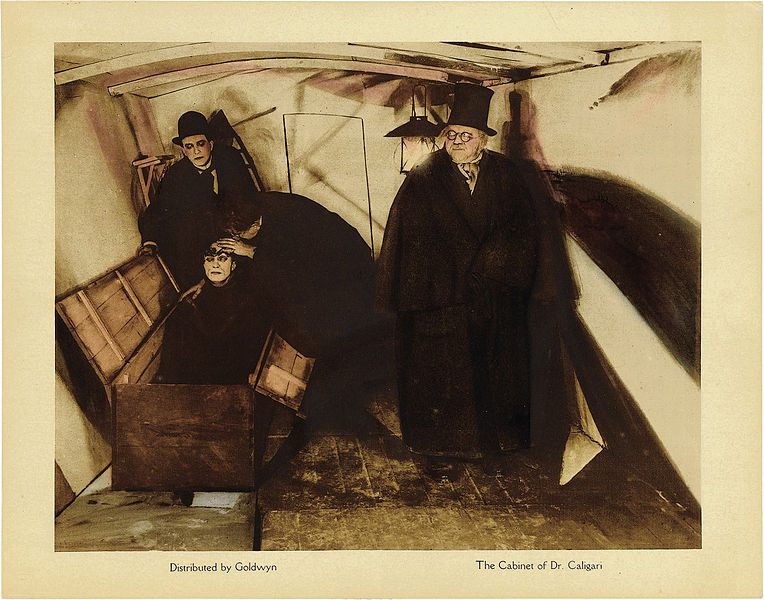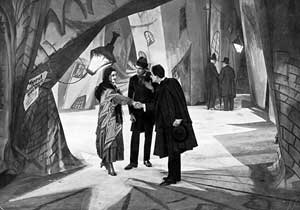The Mad Doctor Meets the Somnambulist
What happens is the first commercially successful art film. The Cabinet of Dr. Caligari (1920) was released in January 1920 becoming a German and international sensation. It marked the beginning of the German film revival during the 1920s
The German Expressionist Movement in German art strongly influenced this film. Expressionist painters drew buildings sloped at odd angles, oddly shaped furniture, etc.
The film’s set design reflected this style of composition. Buildings, doors and streets all slope at odd angles or are irregular shapes. Furniture is also oddly shaped. Chairs seats are six feet in the air, bookcases lean and chairs have irregular backs.
Robert Weine filmed in a standard continuity format making the story understandable to the average viewer. The story itself is a horror and detective story told from one man’s perspective, a story within a story.
A mysterious stranger named Dr. Caligari, played by Werner Krauss, comes to Hollstenwall to display a somnambulist Cesare, portrayed by Conrad Veidt. A somnambulist sleeps for days on end. Calagari says Cesare has slept for 20 να 30 χρόνια. Coincidentally or not, a series of murders occur once Caligari and Cesare arrive in Hollstenwall.
The protagonist of the film is Francis (Friedrich Feher), who is in love with Jane (Lil Dagover). An unknown fiends murder Francis’ friend leading Francis to pursue Dr. Caligari, who Francis believes is responsible for the murder.
The continuous tension between Francis and Caligari drives the story, which is complicated by Cesare’s infatuation with Jane, Francis’ love interest.
Weine filmed a twist ending I won’t spoil for you. Hans Janowitz and Carl Mayer wrote the film and strongly opposed Weine’s changes. Weine did not believe audiences would accept the film without the twist ending.
You will want to view this movie on the Special Collector’s Edition DVD, which restored the film to its original speed of 18 πόδια ανά δευτερόλεπτο. American films were shot at 24 πόδια ανά δευτερόλεπτο. When the original copies for video distribution were made, a copy of the film was recorded on a 24 feet per second projector. The recording at a different speed made the film look a bit quirky and rushed. The film actually has a very deliberate pace, when viewed at the proper projection speed.
The Expressionist scenery will distract you at first. When I first watched the film about ten years ago for a college class, my wife and kids thought I was watching some 1960s psychedelic drug film. Even after explaining Expressionism, they thought it was odd. All three of my children have watched the film to mixed reviews. I will let you decide on the film yourself.
Update: I recently saw the restored version on Netflix. I recommend this copy also.
You can leave a comment or ask a question about this or any post on my Facebook page.
Pin It



